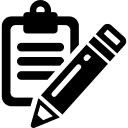
Exam: What you need to know
Topics
Part I: Programming Languages
-
General introduction to Programming Languages ([SCOTT] chapter 1).
- Language design.
- Classification of programming languages.
- Compilation and interpretation.
- Overview of compilation.
-
Clojure fundamentals.
- Read, Evaluate, Print, Loop (REPL).
- Comments.
-
Global and local bindings (
def,let). -
Basic data types (nil, booleans, numbers, strings, characters, symbols, keywords) and their functions:
+,+',-,*,*',/,<,<=,=,not=,==,>,>=,boolean,char,char?,dec,even?,format,inc,keyword?,neg?,nil?,number?,odd?,pos?,quot,rem,str,string?,symbol?, andzero?. -
The
quote(') special form. -
Logic operations:
not,and,or. Short-circuit evaluation. -
Conditions (
if,cond,case). Truthy and falsy values. -
Functions. Definition (
defn) and application. Parameters. Multi-arity and variadic functions. Docstrings. Anonymous functions and closures. Theapplyfunction. - Special forms. How they differ from functions.
-
Repetitions. Recursion and
loop/recur. - Functional programming. Higher-order functions.
- Destructuring.
-
Clojure collections.
- The concept of sequence.
-
Sequence functions:
butlast,concat,cons,count,cycle,distinct,drop,drop-while,empty?,every?,filter,first,interleave,interpose,iterate,last,map,mapcat,nth,partition,partition-by,range,reduce,remove,repeat,rest,reverse,seq,seq?,some,sort,split-at,split-with,take, andtake-while. - Collection types (lists, vectors, maps, and sets).
- Lazy sequences.
-
List functions:
conjandlist. -
Vector functions:
assoc,conj,get,nth,vec, andvector. -
Map functions:
assoc,contains?,dissoc,frequencies,get,keys,merge,vals, andzipmap. -
Set functions:
conj,contains?,disj,get, andset.
-
Parallel programming.
- Concurrency and parallelism concepts.
- Speedup.
- Hardware support for parallelism (multiprocessors, SMT, multi-cores).
-
The
pmapfunction.
Part II: Automata Theory
-
Finite Automata.
- General concepts and terminology (automaton, finite state machine, deterministic and non-deterministic finite automata, alphabet, string, length of string, Kleen star, Kleen plus, language).
- Formal definition of a DFA (Deterministic Finite Automaton).
- DFA state diagrams.
-
Regular Expressions.
- General concept.
- Equivalence between regular expressions and finite automata.
- Syntax. Metacharacters. Special escape sequences.
-
Clojure regular expression functions:
re-matches,re-find, andre-seq.
-
Context-Free Grammars.
- General concept.
- Formal definition of a CFG (Context-Free Grammar).
- CFG derivations and derivation trees.
- The instaparse package for building parsers in Clojure.
-
Turing Machines.
- General concept, components and history.
- TM terminology: accept, reject, loop infinitely, and halt.
- Formal definition of a TM.
- TM state diagrams.
- Universal Turing Machine.
-
Theory of Computation
- Decidable languages (recursive languages). Recognizable languages (recursively enumerable language).
- Undecidable problems. Typical examples (Entscheidungsproblem, halting problem).
- The Church-Turing thesis.
- Turing completeness. Examples of Turing-complete and non-Turing-complete languages.
- The Chomsky hierarchy. Languages and grammars type 0, 1, 2, 3.
Allowed Items During the Exam
NOTE: Once the exam starts you are not allowed to share any items with anyone else.
-
Pen, pencil, eraser, pencil sharpener.
-
Simple scientific calculator. You are not allowed to use a cell phone, programmable calculator, tablet, computer, or any other electronic device.
-
Personal cheat sheet with the following characteristics:
-
Must be one of these:
-
\(5 \times 8\) inches index card (\(12.7 \times 20.32\) cm).
-
Half letter size sheet of paper (\(13.97 \times 21.59\) cm).
-
-
Must be handwritten. Computer-made cards/sheets are not allowed.
-
You can write in both sides of the card/sheet.
-
Must include your student ID and full name on the upper-left corner of both sides of the card/sheet.
-
There are no restrictions on the specific content written on the card/sheet.
-
Sample Questions
-
Write a Clojure function called
contains-all-digits?that takes an integer argument \(n\) and returnstrueif \(n\) contains each of the ten digits from 0 to 9 at least once, orfalseotherwise.Examples:
(contains-all-digits 1023456789) => true (contains-all-digits 1236) => false
-
You are given the following Clojure code:
(defn mystery ([x] (mystery x #(* 2 %) #(inc %))) ([a b c] (c (b a)))) (defn wierd [& t] (let [n (count t)] (cond (zero? n) 1 :else (inc (apply wierd (rest t))))))
What is the result of evaluating the following expressions?
-
(mystery 5) -
(wierd 4 8 15 16 23 42) -
(mystery 2 dec inc) -
(mystery 10 wierd (fn [z] (* z z)))
-
-
You have a sequential program that takes 10 seconds to execute using 1 processor. The parellel version of the same program takes 2 seconds to execute using 8 processors. Calculate its speedup.
-
What is the difference between an ordinary Turing machine (TM) and a universal Turing machine (UTM)?
-
Given \(\Sigma = \{ 0, 1 \} \), you want to define a language \( L \) comprised of all strings that start and end with exactly the same symbol. Thus, these strings belong to this language:
0,010,11001010101. Yet, these other strings do not: \( \varepsilon \),01,110,010010011.- Draw a state diagram of a DFA that accepts \( L \).
- Write a regular expression that accepts \( L \).
- Write a CFG that accepts \( L \).
- Draw a state diagram of a TM that accepts \( L \). NOTE: The final position of the tape head is inconsequential.
- According to the Chomsky hierarchy, what type of grammar and language is \(L\)?